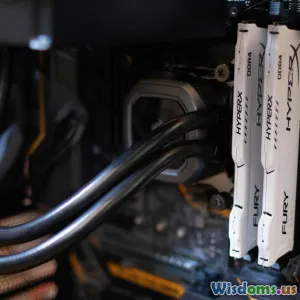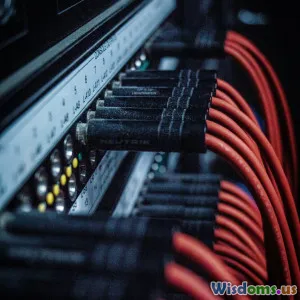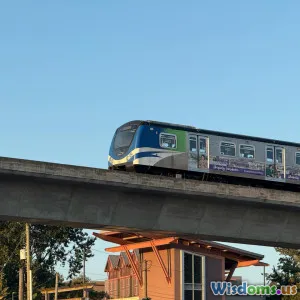
Futureproof Network Performance Trends Predictions for 2025 and Beyond
9 min read Explore essential network performance trends predicted for 2025 and beyond to futureproof digital infrastructures in an evolving technological landscape. (0 Reviews)
Futureproof Network Performance Trends Predictions for 2025 and Beyond
Introduction
The way we connect to the digital world is changing faster than ever. With the rapid adoption of technologies such as 5G, artificial intelligence (AI), and the Internet of Things (IoT), network performance expectations have skyrocketed. Yet, as we edge closer to 2025 and look beyond, new challenges and opportunities are set to redefine the fabric of network infrastructure. How can enterprises, service providers, and technology professionals anticipate and prepare for these seismic shifts? This article dives deep into the futureproof network performance trends for 2025 and beyond, illuminating the path forward with expert insights, emerging technologies, and tangible strategies.
Whether you're a CIO, network engineer, or technology enthusiast, understanding these trends is crucial. They don’t just promise incremental improvements—they threaten to remake how data is routed, secured, and managed across the digital ecosystem.
1. The Evolution of Network Performance Demands
Rising Bandwidth and Latency Expectations
The proliferation of bandwidth-heavy applications—think 8K streaming, augmented reality (AR), virtual reality (VR), and cloud gaming—has propelled demand for high-throughput, low-latency networks. Cisco’s Annual Internet Report forecasts that global IP traffic will reach 45.3 zettabytes per year by 2023, a staggering increase that pushes service providers to rethink network capacity.
Emerging applications, especially in industrial IoT or real-time autonomous vehicle systems, require near-instantaneous data delivery with latencies under a millisecond. Traditional network infrastructures, even with 5G capabilities, struggle to meet these demands without innovative solutions.
Converged Networks and Hybrid Architectures
Networks are no longer just about wired or wireless connectivity; convergence is defining new architectures where traditional data centers blend seamlessly with cloud, edge, and hybrid environments. Guaranteeing performance across these distributed nodes requires new paradigms in monitoring, optimization, and automation.
2. AI and Machine Learning: Transforming Network Management
Smarter Networks through AI-Driven Automation
AI's role in network performance optimization is not speculative—it's happening now and will only intensify. Modern networks generate petabytes of telemetry data daily. AI algorithms analyze this data continuously to identify patterns, predict failures, and automate remediation.
For example, Juniper Networks employs AI-driven systems capable of root-cause analysis at scale, drastically reducing network downtime. Gartner projects that by 2027, 90% of network operations will be AI-assisted, underscoring a seismic shift in how performance is managed.
Predictive Maintenance and Anomaly Detection
By 2025, predictive analytics powered by machine learning will mitigate network disruptions before they occur. Early anomaly detection safeguards against cyberattacks, equipment failures, and configuration errors, directly impacting uptime and user experience.
-- Industry Case: Verizon’s deployment of AI tools has enhanced its ability to predict network bottlenecks, reducing mean time to resolution (MTTR) by over 30% as of 2023.
3. 6G and Beyond: Redefining Wireless Performance
What to Expect from 6G
Though 5G is still rolling out globally, research into 6G is already underway, with expected commercial deployments by 2030. 6G promises data speeds exceeding 1 terabit per second, ultra-low latency under 0.1 milliseconds, and near-perfect reliability.
According to the International Telecommunication Union (ITU), 6G will facilitate advanced applications such as holographic communications, tactile internet, and pervasive intelligence across connected devices.
Impact on Network Architecture
6G will push the edge of networks even further, blending satellite constellations with terrestrial fibers and small cells. It will demand new modulation techniques, dynamic spectrum sharing, and intelligent network slicing.
Real-world pilot projects—like those by Samsung and Huawei—demonstrate 6G’s potential to revolutionize sectors from healthcare (remote surgeries) to smart cities, impacting network configurations and performance monitoring.
4. Edge Computing and Network Performance
The Rise of Edge for Latency-Sensitive Applications
Edge computing—processing data near the source rather than relying on distant cloud servers—has become a cornerstone for future networks. This distributed computing model reduces latency, conserves bandwidth, and enhances data security.
According to a report by MarketsandMarkets, the edge computing market is projected to exceed $100 billion by 2027, with growth driven heavily by 5G and IoT adoption.
Integration Challenges and Opportunities
Integrating edge resources requires orchestrated performance monitoring across heterogeneous hardware and networks. Successful deployments like Microsoft Azure’s edge zones exemplify how co-location of cloud resources and edge facilitates improved QoS, but also introduce complex management requirements.
Innovations like software-defined WAN (SD-WAN) and network function virtualization (NFV) help wield these diverse components under unified control, improving responsiveness and efficiency.
5. Security as a Performance Imperative
Zero Trust Networking’s Influence
Performance enhancement can't be disassociated from security. With increasing cyber threats, zero trust architectures—which assume no user or device is inherently trustworthy—become central to maintaining performance integrity.
Zero trust models reduce attack surfaces and control traffic flows meticulously, which paradoxically improves overall network throughput and minimizes malicious data spikes that degrade performance.
Threat Detection and Adaptive Responses
Security vendors are integrating AI-based threat detection tightly with network monitoring tools. Systems now autonomously differentiate between benign heavy usage and distributed denial of service (DDoS) attacks, dynamically allocating resources to maintain performance.
-- Example: Cloudflare’s adaptive DDoS mitigation uses AI to sustain network availability, protecting nearly 30 million websites worldwide.
6. Sustainable Networking Practices
Green Networking Demands
Energy consumption of network infrastructure is a growing concern. By 2025, sustainability requirements will not only be regulatory but critical to cost management and corporate responsibility.
Telecom operators are innovating energy-efficient hardware, optimizing cooling methodologies, and leveraging AI to reduce unnecessary data transmissions.
Recyclable and Modular Infrastructure
Future-ready networks are shifting to modular designs enabling easy upgrades, reducing electronic waste. Google's data centers, for example, operate at a carbon-neutral level by employing AI-driven energy management, a practice expected to be standard across major providers soon.
Conclusion: Preparing for an Era of Intelligent, Resilient Networks
Predicting network performance trends for 2025 and beyond reveals a compelling narrative of increasing intelligence, seamless integration, and sustainability. Organizations that proactively embrace AI-driven management, prepare for 6G and edge computing, and embed security and green practices at their core will be best positioned to thrive.
As we hurtle toward a hyper-connected future, the ripple effects of these trends will empower innovations previously thought impossible—ushering in new use cases from immersive digital experiences to autonomous systems.
Staying informed and adaptable isn’t just advantageous; it’s imperative. The time to futureproof your network performance strategy is now, or risk being left behind in a world defined by speed, complexity, and relentless technological evolution.
By immersing in these trends today, every network professional can unlock tomorrow’s potential.
Rate the Post
User Reviews
Popular Posts




















